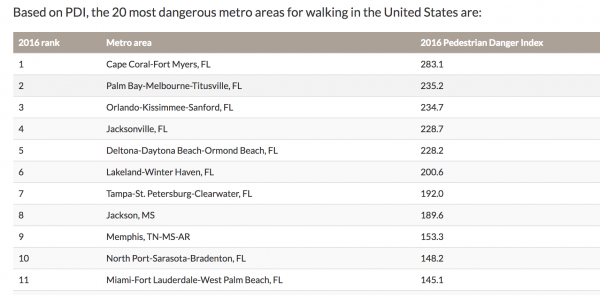
The Smart Pedestrian’s Guide to Safety
B. Morales for Rubenstein Law
Related: Tools to Teach Your Child Pedestrian Safety
Florida is known for many things: theme parks, beaches, sunny weather…and pedestrian fatalities. In a 2016 report ranking 104 US metro areas for pedestrian danger, Florida dominated the top of the list -- with nine of the top 11 most dangerous metro areas for walking.

These statistics are definitely eye-opening, and it inspires one to proceed with caution. Now that the weather is pedestrian-friendly again (so long hurricane season!), here are things to keep in mind when you're out and about.

How to Not Break the Law
Pedestrians may have the right of way in many instances, but that doesn’t mean you should disregard the law. Believe it or not, traffic signs and signals aren't decoration—they’re there for a reason! Traffic laws apply to pedestrian and include:
- Pedestrians do not have the right of way on a green turn arrow.
- Stepping out in front of a vehicle is a no-win situation.
- When not using a crosswalk, give the right of way to vehicles.
- Sidewalks exist for a reason. You can't walk along a street or paved road if they are present.
- Red lights apply to pedestrians too. It's illegal (and not smart!) to cross one.
How to be a Smart Pedestrian
- Check for other vehicles approaching when a car stops for you at a crosswalk or intersection. Yield at each lane to make sure each motorist sees you.
- Choose to cross at intersections (instead of mid-block) where motorists expect pedestrians to approach.

- Never assume a driver has seen you or that they'll predict your actions. Even if a driver does see you cross suddenly, their vehicle may not react on time.
- Stay alert at parking lots, garages or driveways. Check for taillights to indicate moving vehicles.

- Avoid distractions such as electronic devices, music or cell phones. Listen for vehicles and keep your eyes and mind focused on your surroundings.
- Beware of drivers' blind spots behind or beside a car. If you aren’t sure they’ve seen you, avoid walking near the vehicle.
- Look left, right and left again, and wait for traffic to clear completely from both directions before crossing.

- Face traffic when walking or jogging along the road. If there are no sidewalks, stay on the shoulder as far away from traffic as possible.
- Make yourself visible at night. Use a flashlight and reflective tape on clothing, accessories or dog leashes.
- At night, avoid wearing dark colors that will blend you in with your surroundings.
- Make eye contact and signal motorists when crossing.
- Remember, just because you can see the vehicle, doesn’t mean the driver sees you. Motorists can be distracted, driving under the influence or simply fail to see you.
The best defense against pedestrian crashes is to take every precaution necessary. When it comes to pedestrian safety, there is no such thing as being too safe. Enjoy your walk, but please, travel carefully!
Disclaimer: the content above is for informational purposes only, and should not be taken as legal advice nor replace legal counsel in the case of an incident. Readers should not act upon blog information, or decide not to act based upon this information, without first seeking appropriate professional counsel from an attorney licensed in the appropriate jurisdiction. If you are in need of legal assistance for a pedestrian crash, please contact Rubenstein Law at 1-800-FL-LEGAL.




